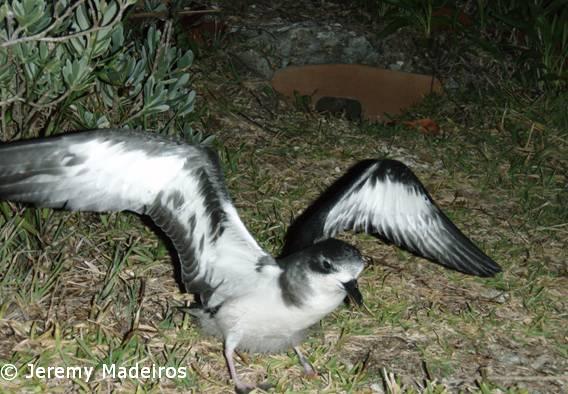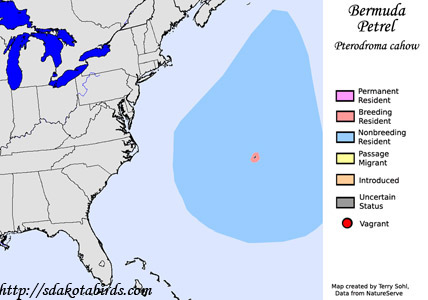| Length: 15 inches | Wingspan: 35 inches | Seasonality: Non-resident in South Dakota |
| ID Keys: Dark, brownish-gray upperparts with some white at base of tail, white belly, underwings are dark around edges, white interior | ||
 The Bermuda Petrel (also known locally as the Cahow) is an amazing story of
a bird "lost" to science, and then rediscovered and brought back from near
extinction, thanks to the work of a handful of devoted individuals.
The first explorers to Bermuda noted the abundance of the species, with
total populations numbering at least several hundred thousand. The
introduction of predators (rats, cats, dogs, and pigs) and heavy hunting of
the species for food rapidly depleted populations, and by 1620, the Bermuda
Petrel was thought to be extinct. By the early 20th century,
there were tantalizing hints that the species may have survived, and in
1951, a handful (less than 20!) individuals were discovered on small rocky
islets at the mouth of Castle Harbor in Bermuda.
The Bermuda Petrel (also known locally as the Cahow) is an amazing story of
a bird "lost" to science, and then rediscovered and brought back from near
extinction, thanks to the work of a handful of devoted individuals.
The first explorers to Bermuda noted the abundance of the species, with
total populations numbering at least several hundred thousand. The
introduction of predators (rats, cats, dogs, and pigs) and heavy hunting of
the species for food rapidly depleted populations, and by 1620, the Bermuda
Petrel was thought to be extinct. By the early 20th century,
there were tantalizing hints that the species may have survived, and in
1951, a handful (less than 20!) individuals were discovered on small rocky
islets at the mouth of Castle Harbor in Bermuda.
Dr. David Wingate began a tireless effort to restore Petrel populations, using an approach that attempted to restore the native ecosystem on Nonsuch Island, an island devoid of breeding Bermuda Petrels, but an isolated and large enough island that offered the best hope for the species in the long term. Predator control efforts on Nonsuch and some of the surround small islets slowly began to improve breeding conditions for Bermuda Petrel. Rats and other predators were eliminated, and Tropicbirds, a competitor for breeding holes with the Bermuda Petrels, were denied entrance to prime breeding locations through the installation of precisely designed "baffles" that allowed Petrels to enter, but restricted the slightly larger Tropicbirds from entering nesting holes. Through ecosystem restoration and predator control, breeding numbers slowly increased. Upon Wingate's retirement, Jeremy Madeiros oversaw restoration efforts, including a bold program to physically move young Bermuda Petrel chicks into nesting holes on the restored ecosystem of Nonsuch Island. The efforts paid off when Petrels returned to Nonsuch and began breeding there for the first time in centuries. Total Bermuda Petrel populations are now up to over 250 (as of 2013), and with continued management of Nonsuch Island, the future of the Petrel is starting to look bright.
The photo above and to the right, taken by Jeremy Maderois, shows a Cahow near an artificial nesting burrow. Note the brownish "baffle" with the specially designed opening that covers the entrance to the nesting burrow in the background. This is an example of the baffles used to keep tropicbirds out of the Cahow nesting burrows.
Habitat: Pelagic outside of the breeding season, found in the North Atlantic. Breeds on a handful of rocky islands in Bermuda, with available nesting burrows and cavities.
Diet: From birds seen at breeding locations in Bermuda, Bermuda petrels are known to feed on small shrimp and small squid. Outside of the breeding season they may also feed on small fish.
Behavior: Takes food by dipping down to the water's surface and grabbing food items with their bill.
Nesting: Nesting occurs in burrows in a few island locations of Bermuda. They formerly nested in soil burrows, constructed by the birds themselves, but with the effective loss of all but a handful of nesting islands, nesting burrows are now often in limestone crevices or artificially constructed burrows. Breeding occurs from January through June. Bermuda Petrels are thought to nest for life, with new nesting partners only recruited if one of the nesting pair should perish. Only a single egg is laid each breeding season, with a very long incubation period of about 52 days.
Interactive eBird Map: Click to access an interactive map of Bermuda Petrel sightings
Song: A very vocal species, the eerie nocturnal cries of the Bermuda Petrel led to some early explorers to declare the islands as the "Devils' place".
Migration: After breeding season in Bermuda, Bermuda Petrels disperse widely in the North Atlantic.
Similar Species: Black-capped Petrel
Conservation Status: Total global populations are still very low, with populations of just a few hundred. However, numbers are increasing through active management of their breeding islands. The IUCN lists the Bermuda Petrel as "Endangered", but notes that continued conservation efforts may allow an upgrading of the status to "Threatened" at some point in the future.
Further Information: 1) The Fabled Cahow - David Wingate
2) Breeding Biology and population increase of the endangered Bermuda Petrel Pterodroma cahow - Jeremy Madeiros et al.
3) BirdLife International - Bermuda Petrel
4) Cornell's NeoTropical Birds - Bermuda Petrel
Photo Information: Photo needed for this species
| Click below for a higher-resolution map |
 |
| South Dakota Status: Non-resident in South Dakota |
Additional Bermuda Petrel Photos (coming soon!!)
